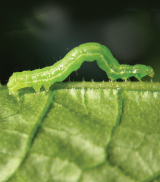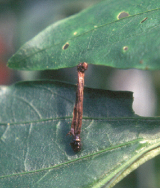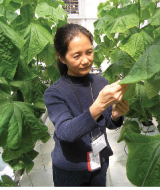
Features
Biocontrols
Inputs
Greenhouse Grower Notes: Microbial control of cabbage loopers
June 28, 2008 By Gillian Ferguson
They not only remove leaf material, but also reduce yield by feeding directly on fruits
Cabbage loopers are a chronic pest in greenhouse vegetable crops during the summer months. This results from an influx of adults from the south in July and August. Generally, cabbage loopers are not able to overwinter in Canada, but if conditions are favourable, they can carry over in greenhouses from one season to the next.
Damage primarily consists of removal of leaf material. It is reported that one cabbage looper can eat 65 cm2 of leaf tissue during its development. Cabbage loopers not only remove leaf material, but they also reduce yield by feeding directly on the fruits. One of the most important tools available to greenhouse vegetable growers for suppression of cabbage loopers is the bacterial insecticide, Bacillus thuringiensis, commonly referred to as Bt. Commercial formulations for use on greenhouse vegetables include Dipel®, Foray® and Bioprotec®. Successful use of Bt requires an understanding of its mode of action and the influence of various factors on its effectiveness.
WHAT IS Bt?
Bt is a naturally occurring bacterium that causes disease in insects. There are thousands of different kinds of Bt that have been classified into over 30 varieties or subspecies. Dipel, Foray and Bioprotec are all of the subspecies kurstaki, and this subspecies is specifically active against caterpillar pests. Bt produces protein crystals that are the toxic component of this organism.
HOW DOES Bt WORK?
Bt is a stomach poison that kills the insect only after the insect has ingested it by feeding on material treated with it. Only insects with a specific gut pH (usually alkaline) are susceptible to the toxic protein. The protein crystals dissolve and liberate toxins when they enter the alkaline medium of the insect’s stomach. The toxins paralyze the gut causing the insect to stop feeding, usually within an hour. This is followed by a slow poisoning of the insect, resulting in death one to seven days after ingestion of Bt. Death of the insect therefore results from the combined effects of starvation and tissue damage. Poisoned cabbage loopers turn from a light green (Fig. 1) of healthy individuals, to dark brown (Fig. 2) as they decompose.
 |

|
|
| Fig 1. Healthy bright green cabbage looper. | Fig. 2. Corpse of cabbage looper following poisoning by Bacillus thuringiensis. |
FACTORS AFFECTING THE EFFECTIVENESS OF Bt
Sunlight – Bt is rapidly degraded by sunlight, particularly ultraviolet light. Field studies show that Bt insecticidal activity degrades rapidly within the first two days after application. By four days after application, insecticidal activity has virtually disappeared. However, Bt applied to more sheltered sites, such as shaded lower leaves, will persist for longer periods. Some studies suggest that Bt can remain active for about one week under greenhouse conditions.
Feeding habit of target insect – Because Bt is a stomach poison, and one that is not systemically transported within the plant, achieving good plant coverage is absolutely essential for good control. Cabbage loopers typically begin feeding on the undersides of leaves and they can escape feeding on Bt residues if such residues are concentrated on the upper surfaces of leaves. The youngest larvae have mouth parts that can only scrape or bite out small bits of leaf tissue without cutting through to the upper leaf surfaces. Only the larger caterpillars have jaws that are sufficiently powerful to cut through the leaf, which will result in them ingesting the upper surfaces of leaves with residues lying there.
Age of larva – The youngest stages are the most susceptible and therefore more easily killed than older ones. Thus, timing of applications to coincide with such stages is critical for good suppression of cabbage looper populations.
TIPS FOR IMPROVING THE EFFECTIVENESS OF Bt
 |
| Gillian Ferguson, greenhouse vegetable IPM specialist |
1. Monitor the crop regularly to determine presence of caterpillars and to detect the early, more susceptible stages as soon as they appear.
2. Ensure good coverage to target very young caterpillars that are feeding only on the superficial tissue of the leaf undersides. To assist in coverage, use as fine a droplet size as possible, and apply as uniformly as possible. Addition of a spreader/sticker may improve coverage.
3. Shorten spray intervals to compensate for the rapid degradation of Bt by sunlight.
4. Apply Bt during evenings, as this can help delay breakdown of the product by sunlight.
5. Ensure proper pH of mixture. The pH of the water before mixing should be 6.0 – 6.5. A high pH will cause breakdown of Bt and reduction in efficacy.
6. Delay development of resistance to Bt by use of alternative control strategies. This means use of light traps early in the year to attract and kill the adults or moths, use of insect screens, sanitation, and biological control agents such as Trichogramma sp., and rotation with a product such as the insect growth regulator, Confirm® (registered for suppression of cabbage loopers on greenhouse pepper, tomato, and lettuce).
Gillian Ferguson is the greenhouse vegetable IPM specialist with the Ontario Ministry of Agriculture, Food and Rural Affairs in Harrow.
- 519-738-1258, or gillian.ferguson@ontario.ca
Print this page